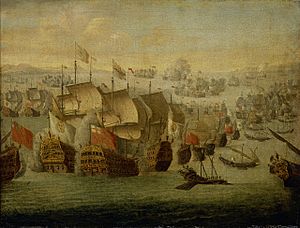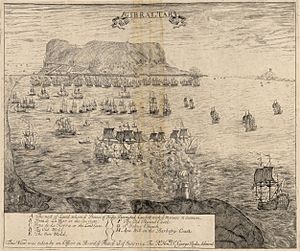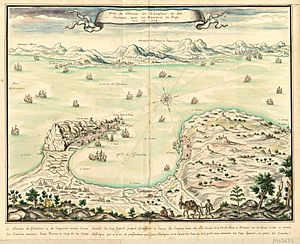Battle of Málaga (1704) facts for kids
Quick facts for kids Battle of Málaga |
|||||||
|---|---|---|---|---|---|---|---|
| Part of the War of the Spanish Succession | |||||||
 A painting of the battle by Isaac Sailmaker |
|||||||
|
|||||||
| Belligerents | |||||||
| Commanders and leaders | |||||||
| Strength | |||||||
| 53 ships of the line 6 frigates 7 fire ships |
50 ships of the line 9 frigates 9 fire ships 24 galleys |
||||||
| Casualties and losses | |||||||
| 3,000 killed | 1,500 killed and wounded | ||||||
The Battle of Málaga, also known as the Battle of Vélez-Málaga, was a huge naval battle. It happened during the War of the Spanish Succession on August 24, 1704. This battle was fought between a combined English and Dutch fleet and the French navy.
Both sides fought very hard for many hours. The English and Dutch ships had to pull back the next day. After the battle, the French fleet went back to their port in Toulon. This meant they did not sail out to sea again for the rest of the war. Because of this, the battle became a big win for the English and Dutch.
This battle happened soon after the English and Dutch captured Gibraltar. Gibraltar is a very important place. The Battle of Málaga was one of many fights for control of Gibraltar during the war.
Contents
Why did the battle happen?

The War of the Spanish Succession began in 1701. It was a big fight over who would rule Spain. On one side were France and Spain, led by the Bourbon family. On the other side was the Grand Alliance. This group included England and the Dutch Republic.
The war started because the King of Spain died without a direct heir. France wanted their prince, Philip of Anjou, to become the new King of Spain. But the Grand Alliance wanted Archduke Charles of Austria to be king instead. They did not want France to become too powerful.
In 1704, an English and Dutch fleet sailed into the Mediterranean Sea. It was led by Sir George Rooke and Dutch Admiral Gerard Callenburgh. They were joined by Prince George of Hesse-Darmstadt. Their goal was to fight the French and Spanish.
After trying to capture Barcelona, they decided to attack Gibraltar. Gibraltar was controlled by the Spanish. On August 1, 1704, the Grand Alliance forces started to attack Gibraltar. They captured it just three days later.
News of Gibraltar's capture quickly reached France. The French navy then sent a large fleet to take it back. Sir George Rooke found out the French were coming. He quickly gathered his ships to stop them.
The Battle of Málaga
On August 22, 1704, the English and Dutch fleet spotted the French ships. Two days later, on August 24, the battle began near the city of Málaga.
Sir George Rooke and Admiral Callenburgh arranged their ships in a long line. This was called a "line of battle." The French ships also formed a similar line. Then, the fighting started. Both fleets fired their cannons at each other for hours. This was called exchanging "broadsides." Many sailors were hurt or killed.
French galleys, which were smaller, oar-powered ships, sometimes helped. They would tow damaged French warships out of the fight. The English and Dutch ships faced a big problem. They were running low on cannonballs and gunpowder. They had used a lot of ammunition when they attacked Gibraltar.
As night came, the English and Dutch tried to share their remaining ammunition. But by the next morning, each ship had very few cannonballs left. The wind also changed, giving the French an advantage. Sir George Rooke and Admiral Callenburgh decided to pull back. They knew they could not keep fighting without enough ammunition.
Neither side lost any ships during the battle. However, many ships on both sides were badly damaged. Some English and Dutch ships lost their masts. The French claimed victory because the English and Dutch pulled away. But the French fleet returned to Toulon and stayed there. This meant the Grand Alliance gained control of the sea in the Mediterranean.
What happened next?
After the battle, Sir George Rooke made sure Gibraltar was safe. He left many men, weapons, and supplies there. Then, he sailed back to England on September 24. He also left some warships behind to patrol the coast.
The Spanish quickly heard that Gibraltar was lost. In early September, the Marquis of Villadarias led 4,000 Spanish troops to Gibraltar. They planned to take it back. Prince George, who was in charge of Gibraltar, quickly made its defenses stronger.
In late September, the Spanish began to surround Gibraltar. French soldiers joined them in October. The Spanish launched several attacks, but the defenders fought them off. The siege continued for months. There were more naval battles and another failed attack in February 1705.
Finally, the Spanish gave up the siege in May 1705. Gibraltar remained under the control of the Grand Alliance for the rest of the war.
The Battle of Málaga showed how important it was for navies to fight in a "line of battle." Both the British and French navies learned from this. They started to train their crews better in using cannons. This battle helped shape how naval battles were fought for many years.
Images for kids
See also
 In Spanish: Batalla de Málaga (1704) para niños
In Spanish: Batalla de Málaga (1704) para niños




